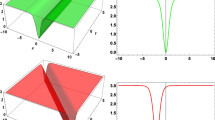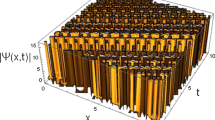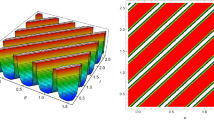Abstract
In this work, we present new two-mode extension to the coupled KdV–Schrodinger equations. This new model arises in many applications in the field of optics, communications and other engineering sciences. It describes the propagation of symmetric bidirectional solitary-waves and their interaction is dependent on a phase-velocity parameter. The celebrated Kudryashov-expansion method is used to find explicit solutions to the new model. The obtained solutions are analyzed by providing 2D and 3D plots and some physical properties are drawn.
Similar content being viewed by others
Avoid common mistakes on your manuscript.
1 Introduction
The topic of nonlinear Schrodinger equation (NLSE) has achieved some remarkable success for many decades, and different types of NLSEs are used in various domains to describe particular phenomena, such as optical solitons in fibers (Triki and Biswas 2011; Zhang and Si 2010; Biswas 2001; Rehman et al. 2021), matter waves in Bose–Einstein Delicacy (Bronski et al. 2001; Trombettoni and Smerzi 2001; Mihalache 2014; Sulaiman et al. 2021), pulses and beams in nonlinear photonics, as well as several others (Nore et al. 1993; Biswas 2003; Eslami and Mirzazadeh 2013; Bulut et al. 2019; Yavuz and Yokus 2020; Aceves et al. 1994). On the other side, the Korteweg-de Vries (KdV) equation describes the motion of shallow-water phenomena arising in quantum mechanics, plasma physics, nonlinear optics and other areas (Jin 2008; Khater et al. 2005; Wazwaz 2006; Biswas and Konar 2007; Karpman 1996).
The motivation of this study is to investigate the bidirectional-waves (Alquran 2021; Alquran et al. 2021) of a new combination of KdV–Schrodinger equations. The classical nonlinear coupled KdV–Schrodinger system has the following form Yavuz et al. (2021)
where \(p=p(x,t)\) is a complex-valued function and \(q=q(x,t)\) is a real-valued function.
The connection between unidirectional-wave and bidirectional-waves was investigated by Korsunsky (1994); Wazwaz (2017). They suggested a general two-mode (TM) nonlinear equations in the following form
\(N=\) nonlinear terms, \(L=\) linear terms, \(s=\) phase velocity (\(s>0\)), \(a=\) nonlinearity parameter (\(|a|\le 1\)) and \(b=\) dispersion parameter (\(|b|\le 1\)). TM equations describe the propagation of bidirectional symmetric waves and their interaction is dependent on the phase-velocity parameter. For the TM equation (1.2), if we substitute \(s=0\) and integrate once with respect to the time-coordinate, we get the following standard single-mode (SM) equation
It is clear that TM is a second-order in time, while SM is a first-order in time. TM belongs models with moving bidirectional waves, while SM belongs models with moving single wave.
In this manuscript, we adapting the Korsunsky-Wazwaz sense (1.2) to construct the two-mode version of (1.1). Accordingly, the two-mode coupled KdV–Schrodinger (TMcKdV-NLS) system takes the following form
where \(\alpha _1,\ \alpha _2\) are the nonlinearity parameters, \(\beta _1,\ \beta _2\) are the dispersions and s is the phase velocity. The model given in (1.4) is presented here for the first time, and our contribution is to find explicit solutions that help to explore the physical structures of TMcKdV-NLS. For more details about two-mode nonlinear equations see (Alquran et al. 2021a, b; Alquran and Yassin 2018)
2 Kudryashov-expansion solution for TMcKdV-NLS
In this section, we extract solitary wave solutions to TMcKdV-NLS by means of the Kudryashov-expansion method. Since the unknown field function \(p=p(x,t)\) is a complex-valued (Jaradat et al. 2018; Alquran and Jaradat 2019; Sulaiman et al. 2021), we write the solution of (1.4) as
and the real-valued function \(q=q(x,t)\) as
where \(\eta =\lambda (x+w t)\) and \(\zeta =x-c t\). The new variables \(\eta \) and \(\zeta \) are regarded as wave transformations with speeds of w and c, respectively. Now, substitution of (2.5)–(2.6) in (1.4) produces
where
Then, we solve the following system
First, by performing the linear combination, \(\lambda (\alpha _1 s-w) R_2- (c+\alpha _1 s) R_1\), we get
Next, we only solve the new system
The Kudryashov method (Jaradat and Alquran 2020; Jaradat et al. 2020; Kudryashov 2012; Alquran et al. 2019, 2021) suggests the following solutions to (2.11)
where \(Y=Y(\zeta )\) satisfies the auxiliary differential equation
The solution of (2.13) is
To determine the indices \(k_1,\ k_2\), we perform the balance procedure by equating the orders of P against \(P''\) in \(R_4\) and \(P^2\) against \(Q''\) in \(R_3\), to obtain \(k_1=k_2=2\). Now, by (2.13) and twice differentiation of the functions \(P,\ Q\) in (2.12), leads to
To this stage, we are ready to substitute (2.15) as well as (2.12) in the last system (2.11), then we collect the coefficients of the same powers of the variable Y, and set each coefficient to zero. The resulting system consists of many nonlinear algebraic equations in the unknowns \(a_0,\ a_1,\ a_2,\ b_0,\ b_1,\ b_2,\ \mu ,\ c,\ w\) and \(\lambda \). To be able solving this inconsistent system, we require some reasonable constraints. Trying many trials, we reached at the following condition
Accordingly, we deduce the following outputs
We should alert here that the wave speed c in (2.17) has two values; \(c=s\) and \(c=-s\). Hence, the TMcKdV-NLS admits having bidirectional wave-solutions which are given by
Figures 1, 2 and 3 represent, respectively, the 3D plot of the bidirectional waves solution, the contour plot and profile solutions to the function p(x, t) as depicted in (2.18) where the Kudryashov parameter d is of a positive value. These bidirectional waves can be regarded as left-wave and right-wave for the reason that both are symmetric and having the same physical structure. On the other side, Figs. 4, 5 and 6 represent the graphical analysis of the reported bidirectional waves to the function q(x, t) with \(d>0\).
3 Interaction of the bidirectional waves of TMcKdV-NLS
In this section we study graphically the impact of both the phase velocity s and the Kudryashov parameter d on the propagations of the obtained bidirectional waves to TMcKdV-NLS. Figure 7 shows the interactions of both left-wave and right-wave of the real-part of the function q(x, t) upon increasing the phase velocity s and having \(d>0\). While as, Fig. 8 shows the interactions of the case of increasing s and having \(d<0\).
Moreover, Fig. 9 is the interaction of left-right waves to the function q(x, t) when s is increasing and \(d>0\), and Fig. 10 is the case of s being increasing and \(d<0\).
4 Conclusion and future work
The new TMcKdV-NLS is introduced in this work for the first time. We observed some physical properties to the new model by providing 2D-3D graphical analysis. Some solutions are obtained to TMcKdV-NLS by means of the Kudryashov-expansion method.
As a future work, more solutions can be obtained to the proposed model by applying other numerical and analytical schemes. Also, N-solitons and lump solutions (Sulaiman and Yusuf 2021) can be investigated to such two-mode model.
References
Alquran, M., Ali, M., Jadallah, H.: New topological and non-topological unidirectional-wave solutions for the modified-mixed KdV equation and bidirectional-waves solutions for the Benjamin Ono equation using recent techniques. J. Ocean Eng. Sci. (2021)
Aceves, A.B., De Angelis, C., Rubenchik, A.M., Turitsyn, S.K.: Multidimensional solitons in fiber arrays. Opt. Lett. 19(5), 329–331 (1994)
Alquran, M.: Physical properties for bidirectional wave solutions to a generalized fifth-order equation with third-order time-dispersion term. Results Phys. 28, 104577 (2021)
Alquran, M., Jaradat, I.: Multiplicative of dual-waves generated upon increasing the phase velocity parameter embedded in dual-mode Schrodinger with nonlinearity Kerr laws. Nonlinear Dyn. 96, 115–121 (2019)
Alquran, M., Yassin, O.: Dynamism of two-mode’s parameters on the field function for third-order dispersive Fisher: application for fibre optics. Opt. Quantum Electron. 50, 354 (2018)
Alquran, M., Sulaiman, T.A., Yusuf, A.: Kink-soliton, singular-kink-soliton and singular-periodic solutions for a new two-mode version of the Burger-Huxley model: applications in nerve fibers and liquid crystals. Opt. Quantum Electron. 53, 227 (2021a)
Alquran, M., Jaradat, I., Sulaiman, T.A., Yusuf, A.: Heart-cusp and bell-shaped-cusp optical solitons for an extended two-mode version of the complex Hirota model: application in optics. Opt. Quantum Electron. 53, 26 (2021b)
Alquran, M., Jaradat, I., Baleanu, D.: Shapes and dynamics of dual-mode Hirota-Satsuma coupled KdV equations: Exact traveling wave solutions and analysis. Chinese J. Phys. 58, 49–56 (2019)
Alquran, M., Yousef, F., Alquran, F., Sulaiman, T.A., Yusuf, A.: Dual-wave solutions for the quadratic-cubic conformable-Caputo time-fractional Klein–Fock–Gordon equation. Math. Comput. Simul. 185, 62–76 (2021). https://doi.org/10.1016/j.joes.2021.07.008
Biswas, A.: A pertubation of solitons due to power law nonlinearity. Chaos Solit. Fractals 12, 579–588 (2001)
Biswas, A.: Quasi-stationary optical solitons with non-Kerr law nonlinearity. Opt. Fiber Technol. 9, 224–229 (2003)
Biswas, A., Konar, S.: Soliton perturbation theory for the compound KdV equation. Int. J. Theor. Phys. 46, 237–243 (2007)
Bronski, J.C., Carr, L.D., Deconinck, B., Kutz, J.N.: Bose-Einstein condensates in standing waves: the cubic nonlinear Schrodinger equation with a periodic potential. Phys. Rev. Lett. 86(8), 1402–1405 (2001)
Bulut, H., Aksan, E.N., Kayhan, M., Sulaıman, T.A.: New solitary wave structures to the \((3+1)\)-dimensional Kadomtsev-Petviashvili and Schrodinger equation. J. Ocean Eng. Sci. 4(4), 373–378 (2019)
Eslami, M., Mirzazadeh, M.: Topological 1-soliton of nonlinear Schrodinger equation with dual power nonlinearity in optical fibers. Eur. Phys. J. Plus 128, 141–147 (2013)
Jaradat, I., Alquran, M.: Construction of solitary two-wave solutions for a new two-mode version of the Zakharov–Kuznetsov equation. Mathematics 8(7), 1127 (2020)
Jaradat, I., Alquran, M., Momani, S., Biswas, A.: Dark and singular optical solutions with dual-mode nonlinear Schrodinger’s equation and Kerr-law nonlinearity. Optik 172, 822–825 (2018)
Jaradat, I., Alquran, M., Ali, M., Al-Ali, N., Momani, S.: Development of spreading symmetric two-waves motion for a family of two-mode nonlinear equations. Heliyon 6(6), e04057 (2020)
Jin, L.: Application of variational iteration method to the fifth-order KdV equation. Int. J. Contemp. Math. Sci. 3, 213–221 (2008)
Karpman, V.I.: Lyapunov approach to the soliton stability in highly dispersive systems. II. KdV-type equations. Phys. Lett. A 2, 257–259 (1996)
Khater, A.H., Hassanb, M.M., Temsaha, R.S.: Cnoidal wave solutions for a class of fifth-order KdV equations. Math. Comput. Simulation 70, 221–226 (2005)
Korsunsky, S.V.: Soliton solutions for a second-order KdV equation. Phys. Lett. A 185, 174–176 (1994)
Kudryashov, N.A.: One method for finding exact solutions of nonlinear differential equations. Commun. Nonlinear Sci. Numer. Simul. 17(6), 2248–2253 (2012)
Mihalache, D.: Multidimensional localized structures in optics and Bose-Einstein condensates: A selection of recent studies. Rom. J. Phys. 59(3–4), 295–312 (2014)
Nore, C., Brachet, M.E., Fauve, S.: Numerical study of hydrodynamics using the nonlinear Schrodinger equation. Phys. D. 65, 154–162 (1993)
Rehman, S.U., Seadawy, A.R., Younis, M., Rizvi, S.T.R., Sulaiman, T.A., Yusuf, A.: Modulation instability analysis and optical solitons of the generalized model for description of propagation pulses in optical fiber with four non-linear terms. Modern Phys. Lett. B 35(06), 2150112 (2021)
Sulaiman, T.A., Yusuf, A.: Dynamics of lump-periodic and breather waves solutions with variable coefficients in liquid with gas bubbles. Waves Random Complex Media (2021). https://doi.org/10.1080/17455030.2021.1897708
Sulaiman, T.A., Younas, U., Yusuf, A., Younis, M., Bilal, M., Rehman, S.U.: Extraction of new optical solitons and MI analysis to three coupled Gross–Pitaevskii system in the spinor Bose-Einstein condensate. Modern Phys. Lett. B 35(06), 2150109 (2021)
Sulaiman, T.A., Bulut, H., Baskonus, H.M.: On the exact solutions to some system of complex nonlinear models. Appl. Math. Nonlinear Sci. 6(1), 29–42 (2021)
Triki, H., Biswas, A.: Dark solitons for a generalized nonlinear Schrodinger equation with parabolic law and dual power nonlinearity. Math. Methods Appl. Sci. 34, 958–962 (2011)
Trombettoni, A., Smerzi, A.: Discrete solitons and breathers with dilute Bose-Einstein condensates. Phys. Rev. Lett. 86(11), 2353–2356 (2001)
Wazwaz, A.M.: Compactons and solitary patterns solutions to fifth-order KdV-like equations. Phys. A 371, 273–279 (2006)
Wazwaz, A.M.: Two-mode fifth-order KdV equations: necessary conditions for multiple-soliton solutions to exist. Nonlinear Dyn. 87(3), 1685–1691 (2017)
Yavuz, M., Yokus, A.: Analytical and numerical approaches to nerve impulse model of fractional-order. Numer. Methods Partial Differential Eqs. 36(6), 1348–1368 (2020)
Yavuz, M., Sulaiman, T.A., Yusuf, A., Abdeljawad, T.: The Schrodinger–KdV equation of fractional order with Mittag-Leffler nonsingular kernel. Alexandria Eng. J. 60, 2715–2724 (2021)
Zhang, L.H., Si, J.G.: New soliton and periodic solutions of \((1+2)\)-dimensional nonlinear Schrodinger equation with dual power nonlinearity. Commun. Nonlinear Sci. Numer. Simul. 15, 2747–2754 (2010)
Author information
Authors and Affiliations
Corresponding author
Ethics declarations
Conflict of interest
The authors declares that they have no conflict of interest.
Additional information
Publisher's Note
Springer Nature remains neutral with regard to jurisdictional claims in published maps and institutional affiliations.
Rights and permissions
About this article
Cite this article
Alquran, M. Optical bidirectional wave-solutions to new two-mode extension of the coupled KdV–Schrodinger equations. Opt Quant Electron 53, 588 (2021). https://doi.org/10.1007/s11082-021-03245-8
Received:
Accepted:
Published:
DOI: https://doi.org/10.1007/s11082-021-03245-8














